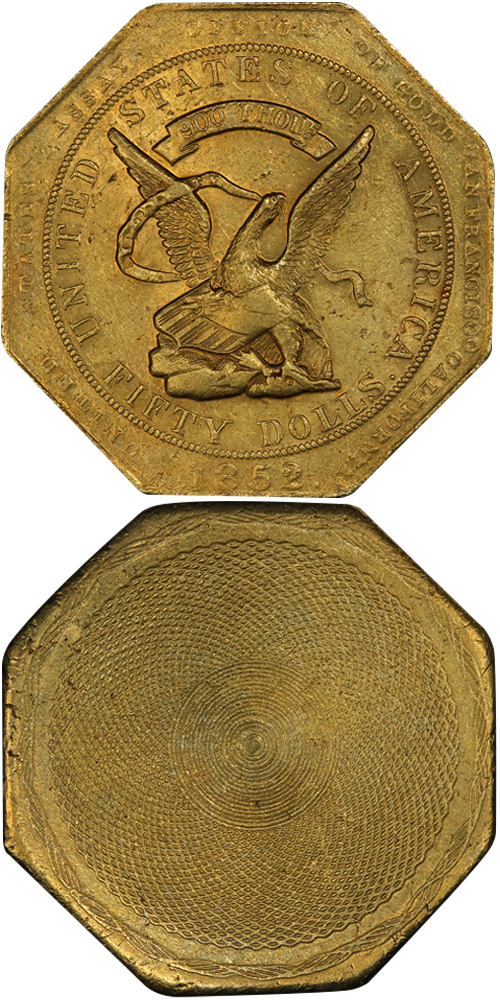1852 United States Assay Office $50.00
K-14, Octagonal, 900 THOUS.
Among the most evocative of all the Gold Rush issues, the huge octagonal $50 gold pieces nicknamed "slugs" have been favorites of numismatists for generations. Tokens and medals made in imitation of the iconic pieces have been produced throughout the twentieth century and even the ever-popular Panama-Pacific Exposition octagonal $50 commemoratives were based loosely on the slugs of the United States Assay Office of Gold. With the discovery of gold at Sutter's Mill in 1848 providing a trustworthy medium of exchange became an important, if not problematic, task. The nearest United States Mint was more than 2,000 miles away in New Orleans over a dangerous land route that would take months to travel. Use of locally mined gold dust and nuggets was fraught with issues as it could be easily adulterated with various and sundry impurities. Currency had long been distrusted in the West, so much so the issuance of obsolete bank notes was forbidden in the state's constitution. Into this environment stepped John Little Moffat and partners Joseph R. Curtis, Philo H. Perry, and Samuel H. Ward. Together they established Moffat & Company and began to produce circulating ingots as well as five dollar gold coins that quickly gained wide acceptance. Meanwhile, the territorial government continued to petition Washington to establish a branch mint in San Francisco. With several Senators not inclined to give California a branch mint, a compromise was reached and instead the United States Assay Office was created but was only authorized to produce ingots in denominations from $50 up to $10,000. To fill the position of assayer, New York watch case maker Augustus Humbert traveled to California where he joined Moffat & Co. who had successfully petitioned Washington for the contract to make the ingots. Humbert brought with him dies prepared by Charles C. Wright and by January 1851 the Assay Office had commenced with coining the octagonal $50 coins. None of the higher denomination ingots have so far been discovered even among the ingots recovered from the S. S. Central America. By 1852, the slugs had become an integral part of the California economy despite their high value. Moffat sold his interest in the company and left the firm all the while Curtis, Perry & Ward retained use of the Moffat & Co. name. This, too, proved to be temporary and not long after Moffat's departure the firm officially dissolved and officially became the United States Assay Office of Gold. When Customs Collector T. Butler King accepted the octagonal slugs in payment for customs duties, the slug's acceptance in the economy became secure.
The earliest of the $50 pieces were produced under Augustus Humbert's name at a non-federal .887 fine standard. Soon after, Humbert's name was removed and the slugs were now struck under the name of the United States Assay Office of Gold but still at the same .887 standard. Things proceeded well for the Assay Office and even smaller denomination coins were struck. An unexpected blow came in the form of legislation passed in August of 1852 that suddenly forbade the Customs Office from accepting any gold coin not struck at the federally-mandated .900 purity. The Kagin-14 $50 pieces were the outcome of that crisis. Petitioned by the local merchants to alleviate the situation, Curtis, Perry and Ward began to produce prodigious quantities of the $50 slugs at the federal standard in January and February 1853, some 23,800 pieces in total, all bearing an 1852 date. Their popularity undiminished, the pieces continued to be used in commerce until finally the state's petitions for a branch mint were heard and the San Francisco Mint began operations. Once the mint was up and running, thousands of the venerable Assay Office $50 pieces ended up in their melting pots to be made into officially sanctioned coins.
Today, perhaps a few hundred slugs are extant in all grades and types, most of which are in circulated grade levels. Because of their huge size and weight (just shy of 2 1/2 ounces of gold), the coins were prone to numerous abrasions and edge dings and other impairments. Uncirculated examples are exceedingly rare and are enthusiastically sought after as the finest examples of a classic design.
The example to the left was sold by Stack's Bowers Galleries in August 2015 Chicago ANA Auction, where it realized $141,000.






